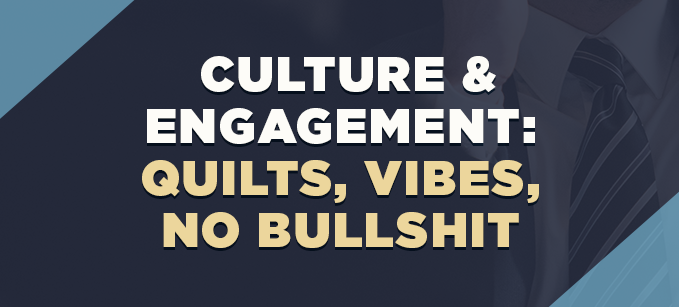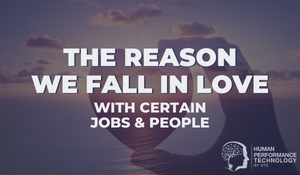Culture & Engagement: Quilts, Vibes, No Bullshit

In this series, we are talking about 6 key drivers that come up time and again in the research on employee engagement. This is part of #5: Good Culture and Co-Workers.
If you've worked in the business juggernaut for any length of time, you have probably worked for a rotten company that hatched a lot of "bad eggs", i.e. people that you couldn't stand to work with.
Ok, well for fun, let's assume that you have. Actually you know what, I just remembered that you did - you just forgot, that's all. So with your permission, I am going to "regress you" and take your mind back through layers of suppressed memories using a count-down memory technique. It's totally safe, I promise. Ok here we go, ready?
3, 2, 1... and cue the wavy-time-warp-with-harp-playing sound effect, like on TV. You know the one.
Wow, it worked, here we are. The year is 1982, and yes, this blog post has a point.
You are starting a new job and you are pumped for your first day. But then, as the week unfolds, you begin to notice things about your new co-workers and daily life that disturbs you. The first thing is obvious; The MD is sexist, has the ego the size of Jupiter and habitually head-butts people as a way of motivating them. You make a mental note to stay out of his orbit. It is also apparent that your department is under-staffed; you will probably have to do the work of three people and, crucially, there always seem to be a shortage of pink coated cookies at lunchtime... this displeases you greatly.
There are other problems too. More serious ones. Bureaucracy, divisive political groups, apathy, disorganisation, mis-trust, hoarding of information and internal competition.
At 3.49pm on a Thursday, two weeks into the job, you are watching a Twix bar uncoil in the cafeteria vending machine and think to yourself "these problems are sending profits, customers, productivity and retention down the chute."
And then the realisation hits you abruptly, painfully, like brain-freeze. You wince in pain as your hand goes to your head.
This company is dying.
It's got cancer. Actually, you realise, it's had it for a while. The poison has probably been around for years, if not decades. Like wood rot, it seems to be part of the walls - the very fabric of organisational life.
This "fabric" is the word we use to describe culture.
We see organisational culture as many little quilted squares that form a patchwork of beliefs, attitudes and behaviours, stitched together, shared by everyone in the organisation, built-up over time. The smaller the company is, the easier it is to clearly see the patterns, colours, designs and to re-stich the fabric quickly. The larger the company is, the more intricate the design becomes and time-consuming the patchwork takes to make changes.

In many research undertakings, culture is found to be the most powerful driving force which determines the success or failure of engagement initiatives. Of course, organisational culture means very different things to different people, has a tendency to be applied to many different contexts and is a word that may contain a lumping together of many ideas, depending on the research methodology.
It follows that it might help to clarify exactly what culture is. Here are some of the best brief descriptions that we find useful:
- "The way we do things around here"
- The spoken and unspoken rules of day-to-day life
- Written and unwritten, explicit and implicit ground rules
- The values, beliefs, attitudes, assumptions and norms that are shared by the group as a whole
- The collective organisational mood
- “It’s the vibe of the thing, your honour...”
The last quote you might recognise. It's one of the most repeated of all Australian made movie lines from The Castle (1997). In that much loved cult movie, the character of Dennis Denuto struggled to convey a strong reason for the court to rule in favour of his client, Darryl Kerrigan. Dennis found himself in the same position that many people have probably found themselves in when asked to articulate what organisational culture means... "uh, it's just the vibe of the place."

One of the best examples of an Australian company's attempt to clearly articulate its culture, is Attlasian. The Melbourne based IT software company has attracted worldwide attention and has won a long list of awards that include innovation, sales growth, best employer, leadership and even the company 'Most Likely to Change the World'. In a 2009 Hewitt Best Employer study, Atlassian staff were surveyed with results showing an engagement score of 87% (well above the Best Employer average engagement rate of 80%).
The driving force of their super-high engagement levels is indeed their culture (which you can get a sense of by watching the video below), underpinned by 6 core values:
- Create useful products people lust after
- Open company, no bullshit
- Don’t f--- the customer
- Build with heart and balance
- Be the change you seek
- Play as a team
Attlasian are one of the country's best examples of a clear-cut culture that drives engagement.
So our question is this: if you were going to print 1 core-culture-value on a t-shirt – what would be the most important one for you? What "patchwork-piece" would you want to see more of?


Theo Winter
Client Services Manager, Writer & Researcher. Theo is one of the youngest professionals in the world to earn an accreditation in TTI Success Insight's suite of psychometric assessments. For more than a decade, he worked with hundreds of HR, L&D and OD professionals and consultants to improve engagement, performance and emotional intelligence of leaders and their teams. He authored the book "40 Must-Know Business Models for People Leaders."

/Simon%20Sinek%20You%20Build%20Trust%20The%20Same%20Way%20you%20Fall%20In%20Love.png?width=374&name=Simon%20Sinek%20You%20Build%20Trust%20The%20Same%20Way%20you%20Fall%20In%20Love.png)

We Would Like to Hear From You (0 Comments)